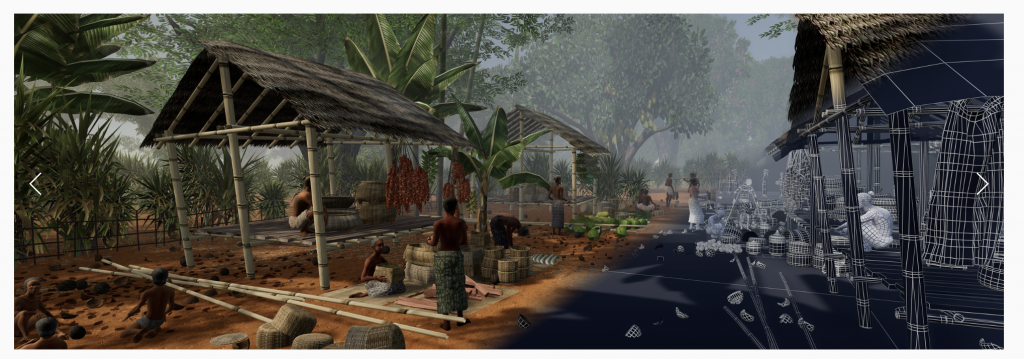Today I explored Virtual Angkor, a website built in order to show off a complete digital 3d model of the historical city of Angkor Wat in the Khmer Empire in what is now Cambodia. The website has a focus on dynamic videos and interactivity, in order to best show the 3d space of the model.
The team behind Virtual Angkor constructed their product with a limited number of sources. This was primarily due to the lack of written sources that were created during the time of the Khmer Empire. The team did have access to one written primary source, which came from the outside perspective of a Chinese diplomat. The team additionally used other open-source software that was available to them in order to begin to construct the location of the major temples and architecture in Angkor. The most notable among these sources was Google Maps street view, which allowed the researchers to navigate in the 3d space of the modern ruins of Angkor. Though the team had access to only a few primary sources, they were able to piece together the one textual source written at the time, the interactive navigation provided by Google Maps and cultural information provided by scholars in order to begin to model Angkor virtually.

In order to process the information they gathered, the virtual Angkor team had to replicate the information they had learned about the city and fill in the blanks with the knowledge of the culture of the Khmer Empire that they had. As shown in the above picture, they began by modeling out the shapes and behaviors of the parts of the world, and later added textures in order to make it appear more realistic. The goal of the team as stated on their website is to create a 3d environment that students can explore in order to spark interest in the world of the Khmer Empire and drive them to investigate more about it on their own. In order to accomplish this goal, the team formatted their data in such a way that creates an immersive, lively environment that is meant to be explored in the form of the dynamic, 3d model of Angkor.
The website immediately shows to a new visitor the detail and scale of the model with an almost full screen video showing multiple scenes taking place within the model, both fully rendered and incomplete. From there, a visitor can choose either to begin exploring on their own, or click on one of the suggested topics shown below the video. On almost every page of the website there are either videos that can be interacted with or galleries that scroll through images. All of this comes together to make the website feel very dynamic and interactive, and leaves the viewer feeling like they are in control of what they learn about the city and its people. All of these visual and interactive choices go back to the team’s goal of creating a website that serves to draw people in and spark an interest in the Khmer Empire and Angkor, rather than to tell them every single detail about the city’s history, culture and more.
I found it interesting that while the website is free and easy to access, it seems that the model of the city itself is not. I feel like releasing the model to the public would be an interesting and potentially beneficial choice, because I would love to see someone figure out how to run it in VR so that someone could actually feel like they are standing in the world that was so meticulously crafted by the team. I touched on the idea that the primary audience that the website is designed for os is young students, and I feel that allowing people to create and access a VR model of the city would further spark the interests of young non-historians learning about the time period. Though I feel like the website as it is now can appeal both to people interested in history and in architecture, I feel like experiencing the city in VR would make it even easier to see the architecture of the city and would draw in more people in that field to learn about Angkor.
I thoroughly enjoyed exploring the world recreated by Virtual Angkor, and I am interested to see how projects like it continue to develop with the prominence of VR and other digital technologies.